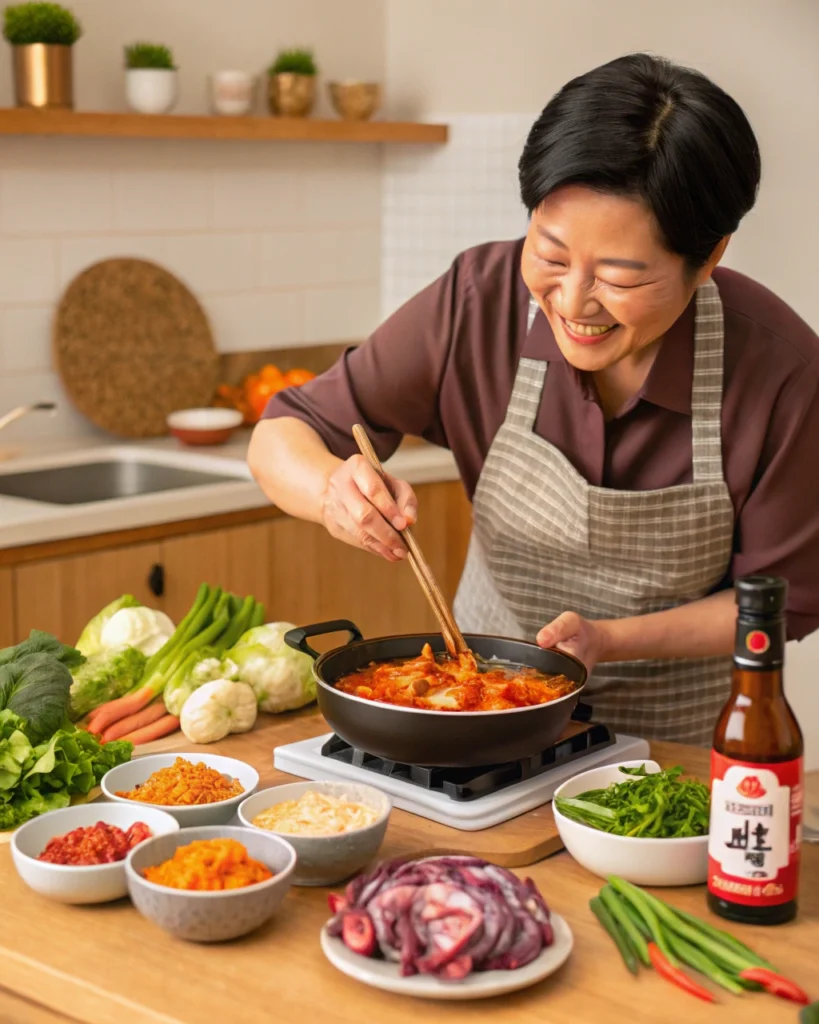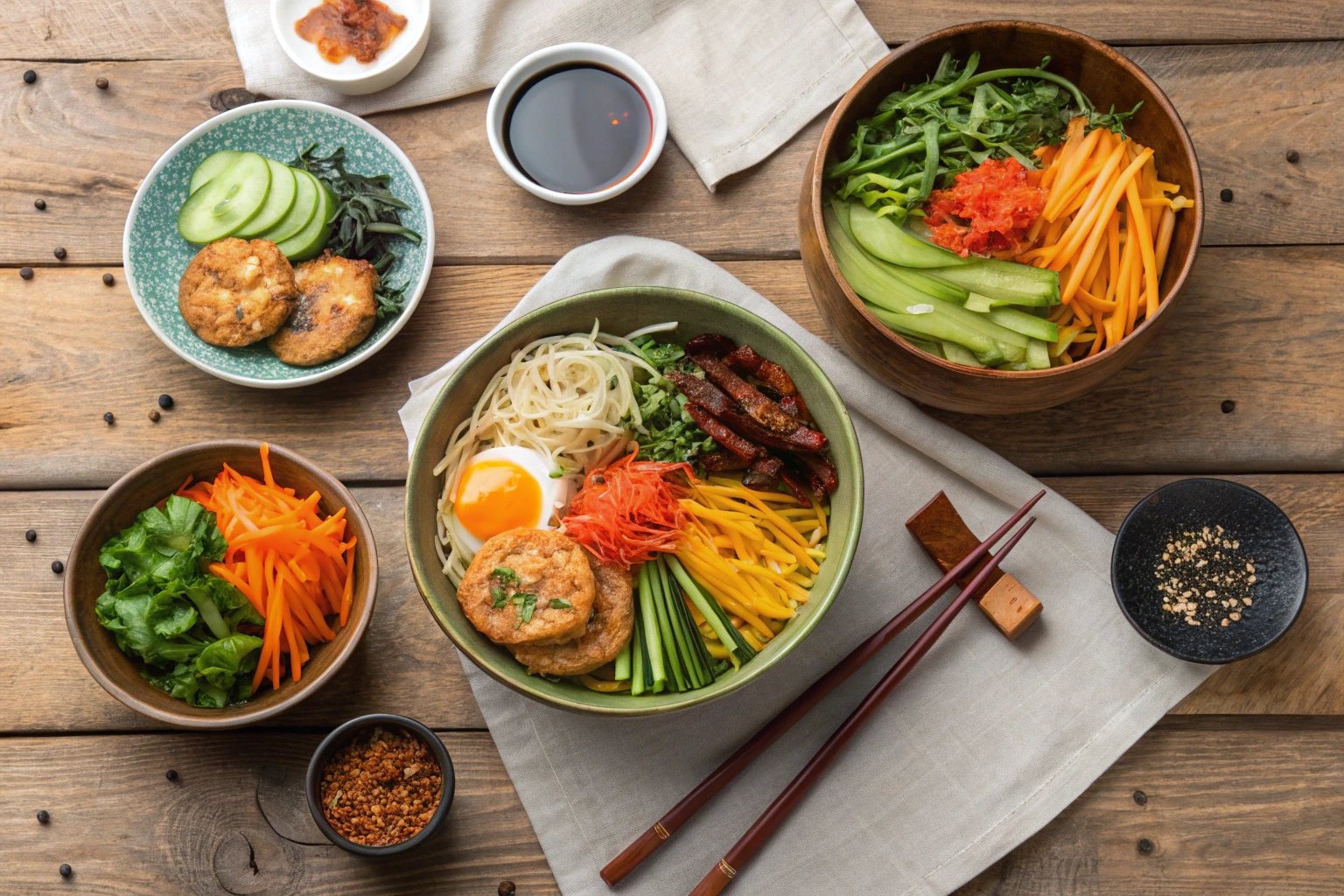If you’re someone who loves exploring new cuisines or looking for fresh, wholesome vegetarian meal ideas, Korean food offers a vibrant and satisfying option. Korean cuisine is known for its vibrant flavors, eye-catching presentation, and a wide variety of ingredients many of which are naturally vegetarian or easily customizable.
When you dive into vegetarian Korean food, you’ll discover dishes that are rich in umami, packed with vegetables, and often boosted by healthy fermented ingredients like kimchi and soybean paste. These recipes bring comfort and excitement to your plate, all while being nutritious and easy to prepare at home.
In this article, you’ll find seven delicious vegetarian Korean food recipes that you’ll want to try, whether you’re a seasoned vegetarian or just starting your plant-based journey. Let’s explore these mouthwatering dishes and learn how to make them yourself.
Table of Contents
Understanding Vegetarian Korean Food: A Cultural and Culinary Overview
Before you jump into cooking, it helps to know what makes Korean food vegetarian-friendly and why it’s so good for you.
What Makes Korean Food Vegetarian-Friendly?
Korean cuisine relies heavily on vegetables, tofu, grains, and fermented sauces like gochujang (spicy red chili paste) and doenjang (fermented soybean paste). These ingredients form the backbone of many dishes. However, some traditional recipes include fish sauce, anchovy broth, or beef stock, so it’s important to substitute those when cooking vegetarian Korean food.
Health Benefits of Vegetarian Korean Cuisine
- Fermented foods like kimchi and doenjang improve gut health by supplying beneficial probiotics.
- Rich in fiber, vitamins, and antioxidants thanks to diverse vegetables.
- Typically low in fat and made with whole ingredients.
- Balanced flavors encourage you to enjoy food mindfully and healthfully.
7 Must-Try Vegetarian Korean Food Recipes

Here are seven classic Korean dishes that shine as vegetarian meals. Each recipe includes an ingredients table and easy-to-follow instructions.
1. Bibimbap (Mixed Rice with Vegetables)
What is Bibimbap?
Bibimbap is a vibrant rice bowl topped with an assortment of sautéed vegetables, tofu, and a spicy gochujang sauce. It’s a perfect harmony of flavors and textures that will delight your senses.
Ingredients
| Ingredient | Quantity |
|---|---|
| Cooked rice | 2 cups |
| Spinach | 1 cup |
| Carrots (julienned) | 1/2 cup |
| Zucchini (sliced) | 1/2 cup |
| Mushrooms (sliced) | 1/2 cup |
| Firm tofu (cubed) | 100g |
| Gochujang sauce | 2 tbsp |
| Sesame oil | 1 tbsp |
| Sesame seeds | 1 tsp |
| Garlic (minced) | 1 clove |
Preparation Steps
- Blanch spinach and season with a pinch of salt and sesame oil.
- Sauté carrots, zucchini, and mushrooms separately until tender.
- Pan-fry tofu cubes until golden on all sides.
- Place cooked rice in a bowl. Arrange vegetables and tofu on top in sections.
- Drizzle with gochujang and sesame oil, then sprinkle sesame seeds.
- Mix everything together before eating.
Tips
- Use brown rice for extra fiber.
- Substitute tofu with tempeh or extra mushrooms if preferred.
2. Kimchi Jeon (Kimchi Pancakes) – Vegetarian Version
Kimchi Jeon is a crispy and savory pancake that’s perfect as a snack or side dish. To keep it vegetarian, use vegan kimchi or make your own without fish sauce.
3. Japchae (Stir-fried Glass Noodles with Vegetables)
Japchae is a well-loved Korean noodle dish made with sweet potato noodles. It’s stir-fried with colorful vegetables like spinach, carrots, and bell peppers. This dish is naturally vegetarian and very tasty.
4. Tteokbokki (Spicy Rice Cakes) – Vegetarian Adaptation
This iconic street food is made with chewy rice cakes simmered in a spicy gochujang sauce. Substitute traditional anchovy broth with vegetable stock to keep it vegetarian.
5. Kongguksu (Cold Soy Milk Noodle Soup)
Kongguksu is a refreshing summer dish featuring noodles served in chilled soy milk broth. It’s creamy, mild, and perfect for warm weather.
6. Doenjang Jjigae (Fermented Soybean Paste Stew) – Vegetarian Style
This hearty stew uses doenjang paste as the flavor base, combined with tofu, zucchini, potatoes, and mushrooms. Use vegetable broth to keep it strictly vegetarian.
7. Vegetable Kimbap (Korean Rice Rolls)
Kimbap is Korea’s version of sushi rolls, filled with rice and assorted vegetables like cucumber, carrots, and spinach, all wrapped in roasted seaweed sheets.
Tips for Cooking Authentic Vegetarian Korean Food at Home
- Substitute non-vegetarian ingredients: Use vegetable broth instead of anchovy or beef broth.
- Source authentic ingredients: Look for Korean markets or online stores for items like gochujang, doenjang, and roasted seaweed.
- Use the right tools: A non-stick pan helps with pancakes and stir-fries; a rice cooker makes cooking rice easier.
- Handle fermented foods safely: Store kimchi and soybean paste properly to maintain freshness and flavor.
Frequently Asked Questions (FAQs) about Vegetarian Korean Food
Q1: Is Korean food generally vegetarian-friendly?
While many Korean dishes are vegetable-heavy, some contain fish sauce or meat broth. With simple substitutions, you can enjoy authentic vegetarian Korean meals.
Q2: How do I make sure my kimchi is vegetarian?
Look for kimchi labeled “vegan” or “vegetarian” or make your own using cabbage, radish, garlic, and gochugaru chili flakes — skip the fish sauce.
Q3: Where can I find vegetarian Korean sauces and pastes?
Gochujang and doenjang are widely available at Asian grocery stores and online shops just be sure to check the labels closely to steer clear of any fish-based ingredients.
Q4: Can I substitute meat with tofu or mushrooms in Korean recipes?
Yes! Tofu, tempeh, and mushrooms provide protein and umami that mimic meat textures and flavors well.
Q5: What are the health benefits of vegetarian Korean cuisine?
Vegetarian Korean food is rich in fiber, vitamins, and probiotics from fermented foods, promoting digestion and overall wellness.

Conclusion
You don’t have to be Korean or vegetarian to appreciate the incredible flavors and health benefits of vegetarian Korean food. These seven recipes offer a fantastic starting point to add bold, nourishing, and satisfying dishes to your meal rotation. Whether you’re cooking for yourself, your family, or friends, these meals promise to delight.
Ready to embark on your vegetarian Korean cooking journey? Try one recipe today, experiment with the flavors, and enjoy a delicious taste of Korea in your own kitchen.
Don’t forget to share your cooking experiences or ask questions below — I’d love to hear your favorites! And if you want more authentic, easy vegetarian recipes from around the world, be sure to subscribe for updates!


